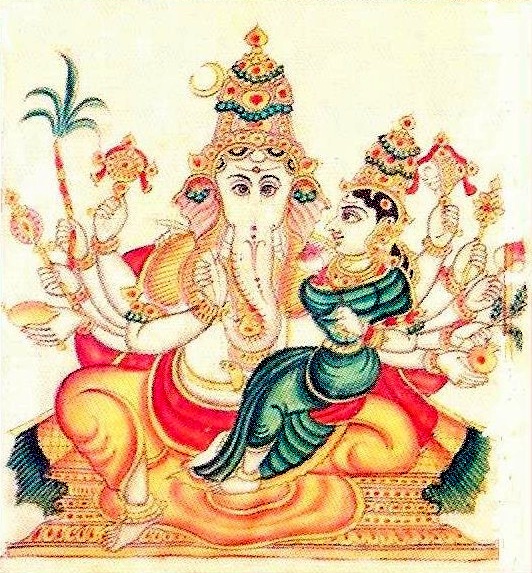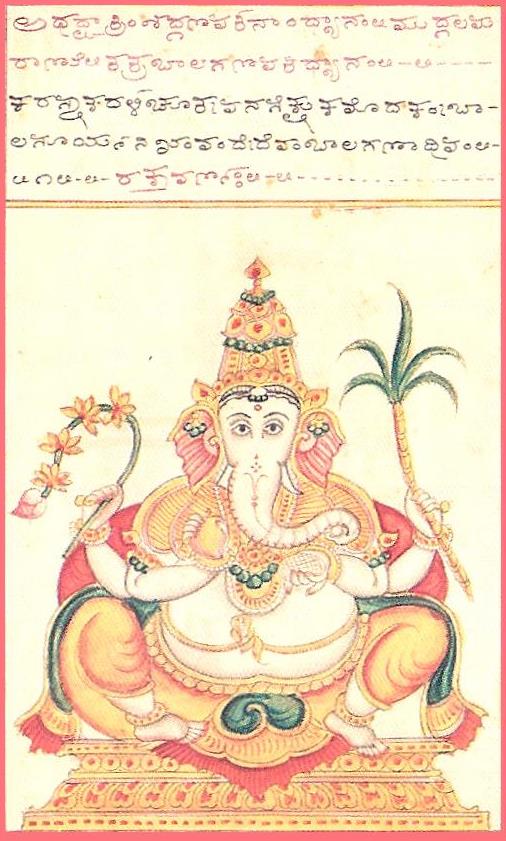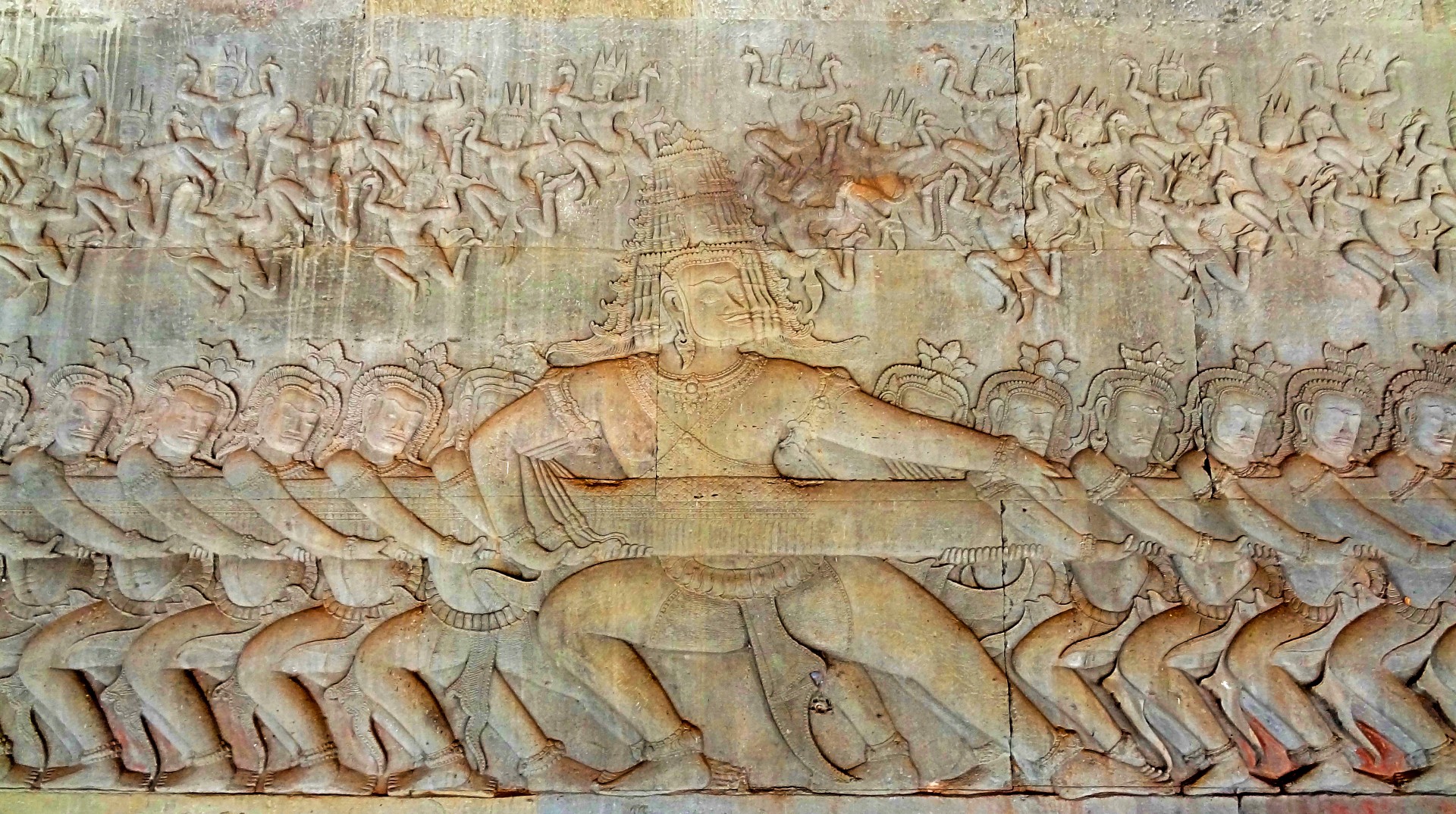|
Mahaganapati
Mahaganapati (, ), literally "Ganesha, the Great"), also spelled as Maha Ganapati, and frequently called Mahaganadhipati, is an aspect of the Hindu god Ganesha. He is the representation of Ganesha as the Supreme Being Paramatman and is the most important deity of the Ganesha-centric Ganapatya sect. He is one of the most popular of the thirty-two forms of Ganesha, worshipped as a representation of the ultimate truth Para brahman. Mahaganapati is depicted as elephant-headed with ten arms carrying various objects and is accompanied by a goddess. Iconography Like all aspects of Ganesha, Mahaganapati has an elephant head. Sindoor, is generally used for his red colour, in depictions. His colour is a reference to the dawn. He is often depicted with a third eye on his forehead, a crescent moon over his head, ten arms which hold; a lotus, a pomegranate fruit, a gada (mace), a chakra (discus), his own broken tusk, a pasha (noose), a jewelled water vessel or a pot of jewels, a blue lo ... [...More Info...] [...Related Items...] OR: [Wikipedia] [Google] [Baidu] |
Ashtavinayak
Ashtavinayaka () is a Sanskrit term which means "eight Ganeshas". The Ashtavinayaka Yatra refers to a pilgrimage to the eight Hindu temples in the state of Maharashtra, India, centered around the city of Pune. The eight temples house eight distinct idols of Ganesha, the Hindu deity of unity, prosperity, learning, and removing obstacles. Each of these temples has its own individual legend and history, as distinct from each other as the murtis in each temple. The form of each murti of Ganesha and his trunk are distinct from one another. There are other temples of eight Ganesha in various other parts of Maharashtra; however, the ones around Pune are more well known and visited. To complete the Ashtavinayaka Yatra, one must revisit the first temple after visiting all the eight temples. The Ashtavinayaka Yatra is a pilgrimage covering these eight holy abodes of Ganesha in and around Pune and Raigad districts of Maharashtra. Out of these 8 Temples, 5 are in Pune district, 2 are i ... [...More Info...] [...Related Items...] OR: [Wikipedia] [Google] [Baidu] |
Ranjangaon Ganpati
Ranjangaon Ganpati also known as Shri Mahaganpati Temple is a Hindus, Hindu temple dedicated to Lord Ganesha, one of the most revered deities in Hinduism. Situated in the village of Ranjangaon within the Shirur taluka of Pune district, Maharashtra, India. It is one of the eight Ashtavinayaka, Ashtavinayak temples venerating Lord Ganesha, bearing immense religious importance in Hinduism. The Ganpati idol in the temple was unveiled and gifted by the "Khollam" family, renowned goldsmiths from Ranjangaon. Constructed between the 9th and 10th centuries, the main temple appears to have been built during the Peshwa era. Positioned atop the entrance gate is the Nagarkhana. The temple, oriented towards the east, has a grand entrance gate. Madhavrao I made a room in the basement of the temple to keep the idol of lord Ganesha. Later on Sardar Kibe of Indore renovated it. The idol of the lord Ganesh is also named as 'Mahotkat', and it is said that the idol has 10 trunks and 20 hands. Whi ... [...More Info...] [...Related Items...] OR: [Wikipedia] [Google] [Baidu] |
Thirty-two Forms Of Ganesha
Thirty-two forms of Ganesha are mentioned frequently in devotional literature related to the Hindu god Ganesha. The Ganesha-centric scripture ''Mudgala Purana'' is the first to list them. Detailed descriptions are included in the ''Shivanidhi'' portion of the 19th-century Kannada ''Sritattvanidhi''. There are also sculptural representations of these thirty-two forms in the temples at Nanjangud and Chāmarājanagar (both in Mysore district, Karnataka), done about the same time as the paintings were done and also at the direction of the same monarch.Ramachandra Rao, p. vi. Each of the thirty-two illustrations is accompanied by a short Sanskrit meditation verse ('), written in Kannada script. The meditation verses list the attributes of each form. The text says that these meditation forms are from the ''Mudgala Purana''. In his review of how the iconographic forms of Ganapati shown in the Sritattvanidhi compare with those known from other sources, Martin-Dubost notes that the Srita ... [...More Info...] [...Related Items...] OR: [Wikipedia] [Google] [Baidu] |
Para Brahman
''Para Brahman'' or ''Param Brahman'' () in Hindu philosophy is the "Supreme Brahman" that which is beyond all descriptions and conceptualisations. It is described as beyond the form or the formlessness (in the sense that it is devoid of Maya) that eternally pervades everything, everywhere in the universe and whatever is beyond. Para Brahman is conceptualised in diverse ways. In the Advaita Vedanta tradition, the Para Brahman is a synonym of ''nirguna brahman'', i.e., the attribute-less Absolute. Conversely, in Dvaita Vedanta and Vishistadvaita Vedanta traditions, the Para Brahman is defined as ''saguna brahman'', i.e., the Absolute with attributes. In Vaishnavism, Shaivism, and Shaktism, Vishnu, Shiva, and Adi Shakti respectively are Para Brahman. Mahaganapati is held to be Para Brahman by the Ganapatya sect, Kartikeya by the Kaumaram. Etymology ''Para'' is a Sanskrit word that means "higher" in some contexts, and "highest or supreme" in others. ''Brahman'' in Hindui ... [...More Info...] [...Related Items...] OR: [Wikipedia] [Google] [Baidu] |
Paramatman
''Paramatman'' (Sanskrit: परमात्मन्, IAST: Paramātman) or ''Paramātmā'' is the absolute '' Atman'', or supreme Self, in various philosophies such as the Vedanta and Yoga schools in Hindu theology, as well as other Indian religions such as Sikhism. ''Paramatman'' is the "Primordial Self" or the "Self Beyond" who is spiritually identical with the absolute and ultimate reality. Selflessness is the attribute of ''Paramatman'', where all personality/individuality vanishes. Etymology The word stem ''paramātman'' (, its nominative singular being ''paramātmā'' — परमात्मा, pronounced ) is formed from two words, ''parama'', meaning "supreme" or "highest", and ''ātman'', which means individual self. The word '' Ātman'' generally denotes the Individual Self, but by the word ''Paramatman'' which word also expresses Boundless Life, Boundless Consciousness, Boundless Substance in Boundless Space, is meant the ''Atman'' of all ''atmans'' or the Supr ... [...More Info...] [...Related Items...] OR: [Wikipedia] [Google] [Baidu] |
Ganapatya
Ganapatya is a denomination of Hinduism that worships Ganesha (also called Ganapati) as the Parabrahman, Saguna Brahman.Ganapatyas Article from PHILTAR, Division of Religion and Philosophy, St Martin's College Beliefs The worship of is considered complementary with the worship of other deities. Hindus of all sects begin prayers, important undertakings, and religious ceremonies with an invocation of Ganesha, because of Ganesha's role as the god of beginnings. But although most Hindu sects do revere Ganesha, the Ganapatya sect goes further than that, and declares Ganesha to be the supreme being. Ganapatya is one of the five principal Hindu sects which focus on a particular deity, along ...[...More Info...] [...Related Items...] OR: [Wikipedia] [Google] [Baidu] |
Asura
Asuras () are a class of beings in Indian religions, and later Persian and Turkic mythology. They are described as power-seeking beings related to the more benevolent Devas (also known as Suras) in Hinduism. In its Buddhist context, the word is translated as "titan" or " antigod". According to Hindu texts, the asuras are in constant fear of the devas. Asuras are described in Indian texts as powerful superhuman demigods with good or bad qualities. In early Vedic literature, the good Asuras are called '' Adityas'' and are led by Varuna, while the malevolent ones are called '' Danavas'' and are led by Vritra. In the earliest layer of Vedic texts, Agni, Indra and other gods are also called Asuras, in the sense of their being "lords" of their respective domains, knowledge and abilities. In later Vedic and post-Vedic texts, the benevolent gods are called ''Devas'', while malevolent Asuras compete against these Devas and are considered "enem ... [...More Info...] [...Related Items...] OR: [Wikipedia] [Google] [Baidu] |
Avatar
Avatar (, ; ) is a concept within Hinduism that in Sanskrit literally means . It signifies the material appearance or incarnation of a powerful deity, or spirit on Earth. The relative verb to "alight, to make one's appearance" is sometimes used to refer to any guru or revered human being. The word ''avatar'' does not appear in the Vedic literature; however, it appears in developed forms in post-Vedic literature, and as a noun particularly in the Puranic literature after the 6th century CE. Despite that, the concept of an avatar is compatible with the content of the Vedic literature like the Upanishads as it is symbolic imagery of the Saguna Brahman concept in the philosophy of Hinduism. The ''Rigveda'' describes Indra as endowed with a mysterious power of assuming any form at will. The ''Bhagavad Gita'' expounds the doctrine of Avatara but with terms other than ''avatar''. Theologically, the term is most often associated with the Hindu god Vishnu, though the idea has been ... [...More Info...] [...Related Items...] OR: [Wikipedia] [Google] [Baidu] |
Varaha
Varaha (, , "boar") is the avatar of the Hinduism, Hindu god Vishnu, in the form of a wild boar, boar. Varaha is generally listed as third in the Dashavatara, the ten principal avatars of Vishnu. In legend, when the demon Hiranyaksha steals the earth goddess Bhumi (goddess), Bhumi and hid her in the primordial waters, Vishnu appears as Varaha to rescue her. Varaha kills Hiranyaksha and retrieves the earth from the cosmic ocean, lifting her on his tusks, and restores her to her place in the universe. Varaha is depicted as a boar or in an anthropomorphic form, with a boar's head and the human body. Varaha often depicted lifing his consort Bhumi, the earth. Etymology and other names The deity Varaha derives its name from the Sanskrit word ''varaha'' (Devanagari: वराह, ) meaning "boar" or "wild boar". The word ''varāha'' is from Proto-Indo-Iranian language, Proto-Indo-Iranian term ''warāȷ́ʰá'', meaning boar. It is thus related to Avestan ''varāza'', Kurdish lan ... [...More Info...] [...Related Items...] OR: [Wikipedia] [Google] [Baidu] |
Kubera
Kubera (, ) also known as Kuvera, Kuber and Kuberan, is the god of wealth, and the god-king of the semi-divine yakshas in Hinduism. He is regarded as Guardians of the directions, the regent of the north (''Dikpala''), and a protector of the world (''Lokapala''). His many epithets extol him as the overlord of numerous semi-divine species, and the owner of the treasures of the world. Kubera is often depicted with a plump body, adorned with jewels, and carrying a money-pot and a club. Originally described as the chief of evil spirits in Veda, Vedic-era texts, Kubera acquired the status of a ''Deva (Hinduism), deva'' (god) only in the Puranas, ''Purana''s and the Hindu epics. The scriptures describe that Kubera once ruled Lanka, but was overthrown by his half-brother Ravana, later settling in the city of Alaka in the Himalayas. Descriptions of the "glory" and "splendour" of Kubera's city are found in many scriptures. Kubera has also been assimilated into the Buddhist and Jain pa ... [...More Info...] [...Related Items...] OR: [Wikipedia] [Google] [Baidu] |
Tantra
Tantra (; ) is an esoteric yogic tradition that developed on the India, Indian subcontinent beginning in the middle of the 1st millennium CE, first within Shaivism and later in Buddhism. The term ''tantra'', in the Greater India, Indian traditions, also means any systematic broadly applicable "text, theory, system, method, instrument, technique or practice". A key feature of these traditions is the use of mantras, and thus they are commonly referred to as Mantramārga ("Path of Mantra") in Hinduism or Mantrayāna ("Mantra Vehicle") and Guhyamantra ("Secret Mantra") in Buddhism. In Buddhism, the Vajrayana traditions are known for tantric ideas and practices, which are based on Indian Tantras (Buddhism), Buddhist Tantras. They include Tibetan Buddhism, Indo-Tibetan Buddhism, Chinese Esoteric Buddhism, Japanese Shingon Buddhism and Nepalese Newar Buddhism. Although Southern Esoteric Buddhism does not directly reference the tantras, its practices and ideas parallel them. In Bud ... [...More Info...] [...Related Items...] OR: [Wikipedia] [Google] [Baidu] |






